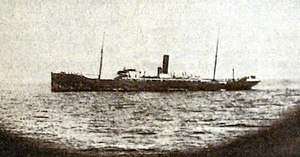Action of 10 March 1917
The Action of 10 March 1917 was a single-ship action during the First World War fought between the Imperial German Navy merchant raider SMS Möwe, and the armed New Zealand Shipping Company cargo ship SS Otaki. Although Otaki was sunk, Möwe was badly damaged.
Background
SMS Möwe was already famous. Her commander, Korvettenkapitän Count Nikolaus zu Dohna-Schlodien, had taken Möwe around the world in 1915 and early 1916, sinking several vessels and fighting one engagement on 16 January with the British. With a veteran crew and ship, Kapitän Dohna-Schlodien slipped past the British blockade of Germany in December 1916 and headed for the mid-Atlantic, taking several vessels along the way.
Action
On 10 March 1917, after months at sea and now returning to Germany, Möwe was in open ocean. At about 02:00, she encountered the 4,491-ton Pacific Steam Navigation Company vessel SS Esmerelda, which was sailing west to Baltimore. Esmerelda was stopped, her crew was taken off and then she was scuttled with explosives.
Just then, a second merchant ship, SS Otaki, appeared on the horizon. She was a 7,420-gross-ton refrigerated cargo ship of the New Zealand Shipping Company[2] sailing from London to New York. Her defence was a single 4.7 inch gun mounted aft with a Royal Navy commander and gun crew of two.
Otaki carried a wireless and could have alerted the British to Möwe's position. In heavy seas and squalls Dohna-Schlodien immediately gave chase, and when she drew near, Dohna-Schlodien signalled Otaki to stop. Her master, Archibald Bisset Smith, refused to surrender his ship. The Germans fired warning shots and were answered with heavy fire from Otaki's stern 120-millimeter gun.

Shot after shot pounded Möwe at a range of 2,000 yd (1,800 m); the New Zealand ship's crew badly damaged the raider before the Germans were capable of firing a shot in return. When Möwe began counter firing, her 150-millimeter shells were accurately directed. Several shells struck Otaki, and after a battle that lasted around 20 minutes, she capsized and sank. The New Sealand colours were never struck; Lieutenant Smith directed his crew to abandon ship, but he stayed behind.[3] By the end of the action, the German auxiliary cruiser was on fire, so her crew had to extinguish the flames as a matter of priority. Five crewmen and Smith went down with Otaki; the survivors were quickly rescued by the Germans. One of the dead was a 14-year-old midshipman; a memorial at Auchindoir Old Kirk in Aberdeenshire commemorates his falling in action. Well over 200 prisoners were taken from Esmerelda and Otaki. Möwe suffered heavily as well, most of Otaki's rounds striking topside; five men were killed, another ten were wounded.
Aftermath
The damage caused by Otaki started fires in Möwe's coal bunkers, which burned for two days and nearly reached the ship's magazine.[4] She had already suffered serious flooding after being holed by Otaki's shells; this had required counter-flooding to correct the list, and more was let in to quench the fires. Due to the damage his ship sustained, Dohna-Schlodien was forced to consider returning to Germany. Within a month the raider was back in friendly waters after running past the British blockade a fourth and final time. Once again Dohna-Schlodien was rewarded accordingly. The survivors of Otaki and the crew of Esmerelda were taken to Brandenburg, where they remained prisoners for the rest of war. Möwe spent the remainder of the war serving with the German fleet in the Baltic Sea as a minelayer.
Archibald Smith's actions were not fully recognized until after the end of the war. For "conspicuous gallantry and devotion to duty", he was given a posthumous promotion to temporary Lieutenant in the Royal Naval Reserve so that he could be awarded the Victoria Cross, which as a civilian he was otherwise ineligible for.
Notes
- Cranwell 1970, p. 243.
- Launched 1908: ss OTAKI Clydesite.co.uk
- Bridgland 1999, p. 200.
- Halpern 2012, p. 371.
References
- Bridgland, T. (1999). Sea Killers in Disguise. Annapolis: Naval Institute Press. ISBN 9781557508959.CS1 maint: ref=harv (link)
- Cranwell, J. P. (1970). Spoilers of the Sea. New York: Books for Libraries Press. ISBN 9780836915631.CS1 maint: ref=harv (link)
- Halpern, P. G. (2012). A Naval History of World War I. Annapolis: Naval Institute Press. ISBN 9781557503527.CS1 maint: ref=harv (link)
Further reading
- Hoyt, E. P. (1970). Elusive Seagull. Frewin. ISBN 0091015707.
